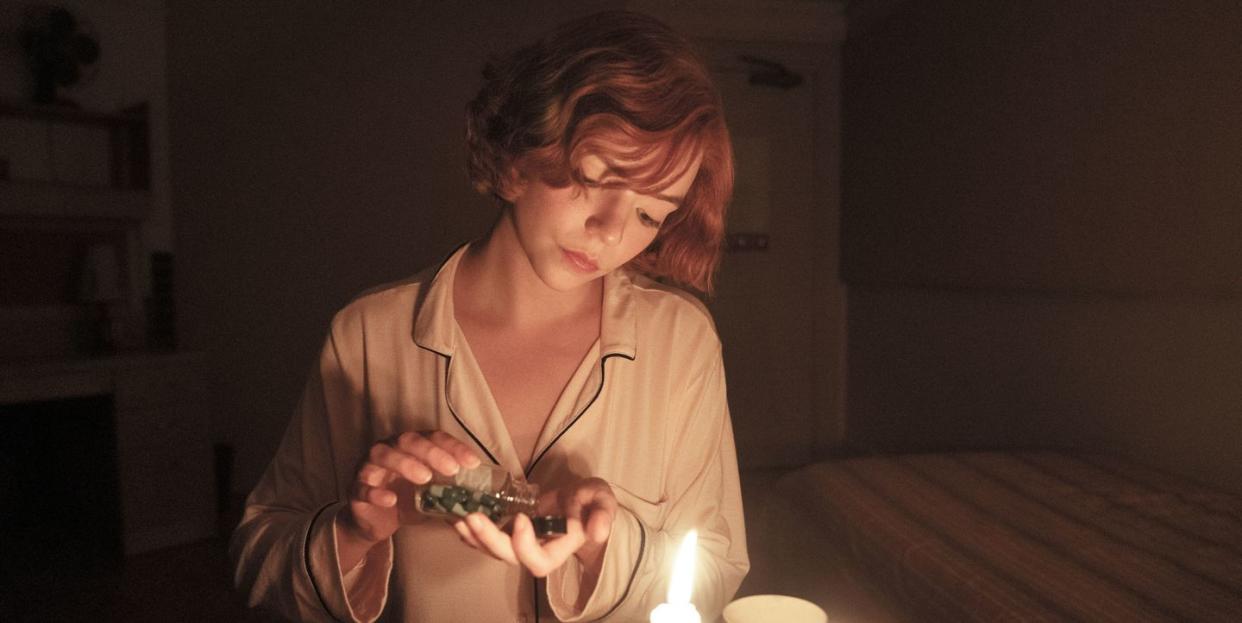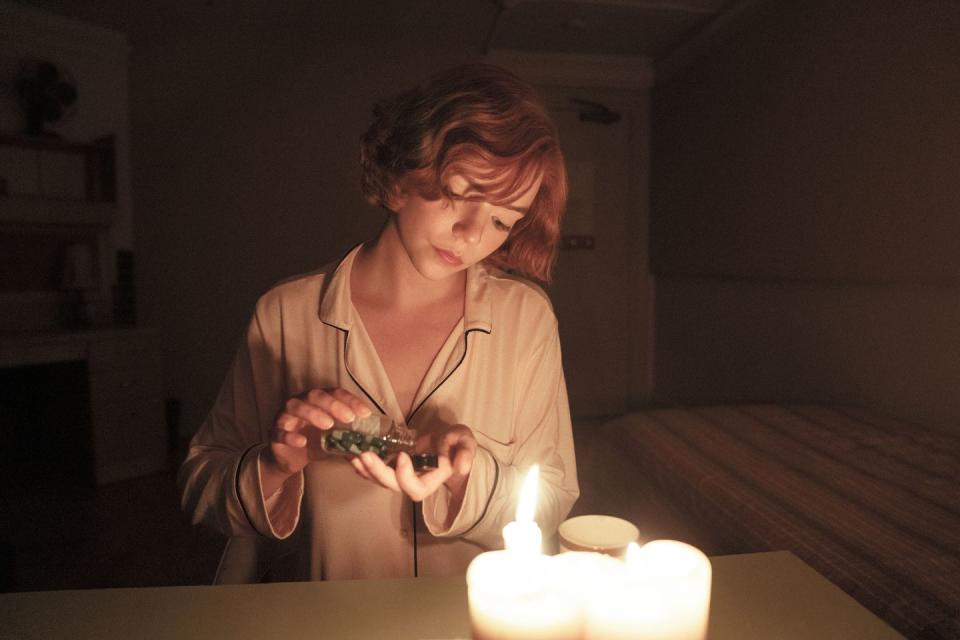Here’s The Real-Life History Behind Those Green Pills In 'The Queen's Gambit'

In Netflix's latest binge-all-you-can drama The Queen's Gambit, Beth Harmon, the protagonist of the seven-episode miniseries, owes a lot of her chess prowess to her own natural talent (and a special thanks to Mr. Shaibel, the custodian at the orphanage who first teaches Beth the game). But she also owes a little of her success in every match—okay, more than she'd like to admit, tbh—to those green pills she takes.
These little "vitamins," as Beth's fellow orphan, Jolene, calls them, are as much a character and formidable foe as her chess competitors. With so much of the show focused on Beth's dependency on the medication, it's no surprise that viewers are wondering: What exactly are these seemingly magic pills anyway?
Here's everything we know about the green pills in The Queen's Gambit:
What are the green pills at the orphanage?
In the show, Beth is first given the pills at the orphanage where she grows up. The staff calls them "vitamins" and gives one to every child daily. They aren't vitamins, but actually tranquilizers that have a drowsy effect. When Beth first takes one, it causes her to stumble around.
Following a tip from Jolene, Beth learns to save the pills for just before bedtime and quickly becomes addicted to them. The problem of her dependency is only exacerbated when it becomes illegal for orphanages to just dole out these pills, and all the kids are cut off without warning.
However, the medication reappears later when Beth's adoptive mother has her own prescription, and Beth finds herself again relying on the green pills. At this point, you learn the green pills come in a bottle labeled "Xanzolam," which isn't a real drug name—as of yet, anyway—but its look and effects are similar to an actual medication that was popular in the 1960s.
Are the green pills based on a real-life drug?
While "Xanzolam" isn't a real drug, the answer, most likely, is yes. The pills bear a striking resemblance to Librium or chlordiazepoxide, a benzodiazepine sedative that often came in half-green capsules, according to Newsweek. The drug was first introduced in the '60s as a treatment for anxiety or insomnia and was often used to help manage the symptoms associated with alcohol withdrawal.
Librium should be kept out of children's reach, according to the Cleveland Clinic, which notes children as young as 6 years may get a prescription for selected conditions. The drug can also be abused.

Beth's substance abuse is inspired by real life experiences.
In fact, the author of the book the Netflix series is based on, also titled The Queen's Gambit, wrote from his own life experience. "When I was young, I was diagnosed as having a rheumatic heart and given heavy drug doses in a hospital. That's where Beth's drug dependency comes from in the novel," author Walter Tevis told The New York Times in 1983. "Writing about her was purgative. There was some pain—I did a lot of dreaming while writing that part of the story. But artistically, I didn't allow myself to be self-indulgent."
Anya Taylor-Joy, who portrays Beth, also talked about her character's substance abuse in a recent TV Insider interview. "She discovers chess at the same time she's being given tranquilizers," Anya says. "It sends her on a difficult course."
Are hallucinations a common side effect of the pills?
Beth's nightly routine of playing chess with giant pieces skittering across a checkerboard on her ceiling seems pretty far-fetched. However, hallucinations are one of the reported side effects of the real-life drug Librium. Some real users experienced vivid dreams and nightmares, and 16 out of 100 had "excessive dreaming," according to a study of Librium from 1968.
Additionally, the pills seem to help Beth focus as she practices new chess skills and give a sense of "tranquility" to Beth's new mom.
However, in one particularly jarring scene, Beth is shown collapsing in a potential overdose after taking multiple pills. This behavior could be in line with a Librium overdose, Newsweek reported, which could manifest in a variety of symptoms including sweating and chills, muscle tremors, fever, difficulty breathing, rashes, irregular heartbeats, and seizures.
Additional side effects include dizziness, confusion, loss of balance, and suicidal thoughts or actions, per the Cleveland Clinic.
If you or someone you know is struggling with substance abuse, call the National Drug Helpline at 1-844-289-0879 or contact the Drug Abuse Hotline at Help.org.
You Might Also Like

